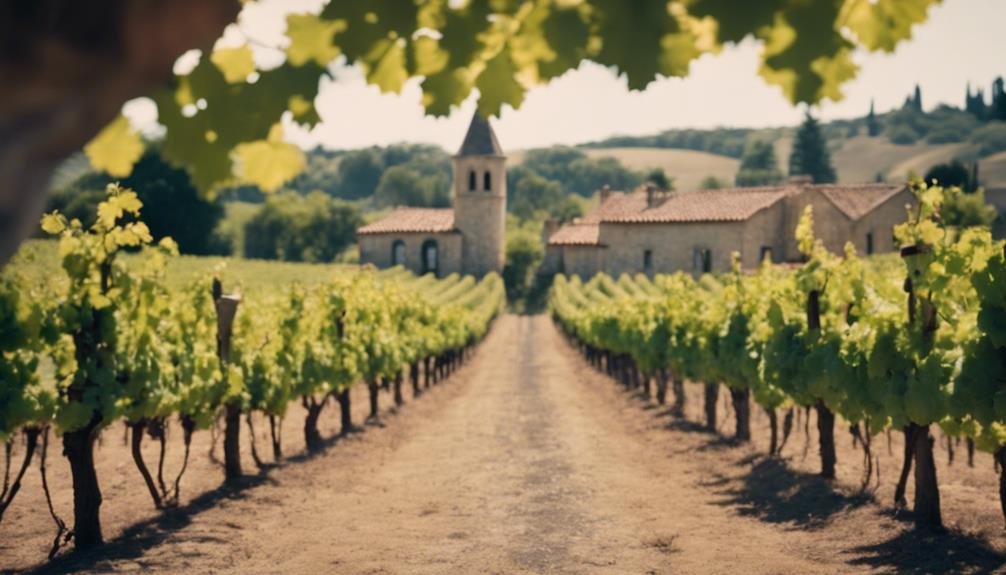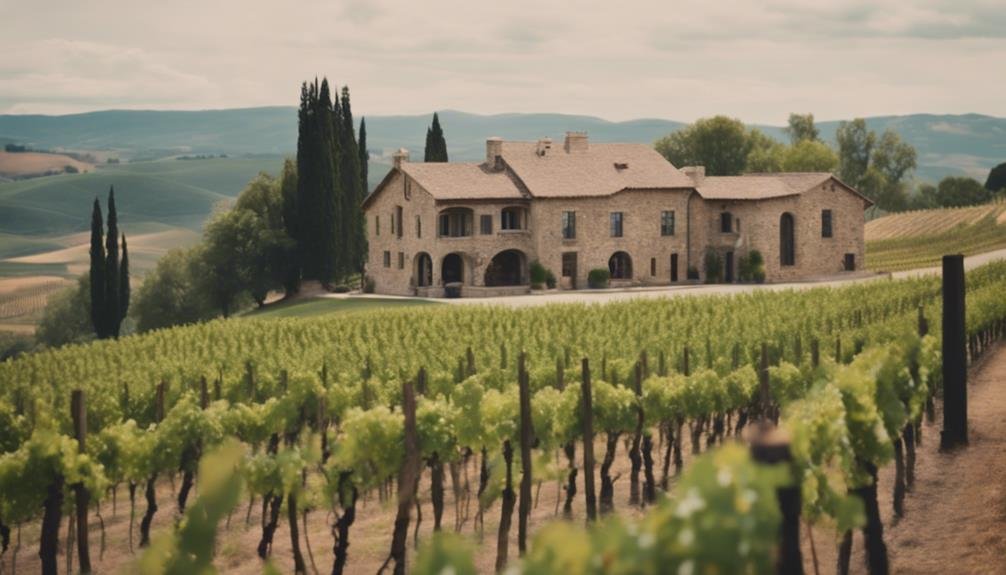In the world of wine, Cabernet Sauvignon and Merlot engage in a battle of bold flavors. Cabernet boasts savory black currant and pepper notes, high tannins, and aging potential. Meanwhile, Merlot offers fruit-driven plum and cherry flavors with a smoother finish, ideal for food pairings. These differences stem from their Bordeaux roots, dating back to the 1600s. Tannin levels, influenced by climate, play a significant role in their boldness. Old World wines emphasize earthy tones, while New World styles highlight fruit characteristics. Understanding these nuances can help in selecting the perfect bottle for your preferences. Explore further for a deeper insight into these wine titans.
Flavor Profiles of Cabernet and Merlot
In comparing the flavor profiles of Cabernet Sauvignon and Merlot, their distinct characteristics offer a unique sensory experience for wine enthusiasts.
Cabernet Sauvignon presents savory black currant and pepper flavors, with higher tannins and a longer finish, making it an excellent choice for aging potential and gifting due to its price points.
On the other hand, Merlot showcases fruit-driven plum and cherry flavors, less tannin, and a smoother finish, making it a great partner for food pairings and appealing to varied palate preferences.
While Cabernet Sauvignon can stand alone without food, Merlot shines when paired with dishes. Understanding these differences can help in appreciating the nuances of each wine and selecting the most suitable option for different occasions.
Sweetness Comparison and Taste Variations
Comparing the sweetness levels and taste variations between Cabernet Sauvignon and Merlot reveals intriguing nuances in their flavor profiles and sensory characteristics.
While neither is technically sweeter, Merlot often exhibits fruitier notes compared to Cabernet Sauvignon. These flavor nuances can vary based on the grape's origin, with factors like climate and soil playing a significant role.
Preferences for these wines can differ based on individual taste preferences, with some preferring the bolder, high-tannin characteristics of Cabernet Sauvignon, while others enjoy the smoother, fruit-driven flavors of Merlot.
Understanding the differences in sweetness levels and taste variations can help wine enthusiasts appreciate the unique qualities each varietal brings to the glass, making for an exciting exploration of these popular red wines.
Historical Roots of Cabernet and Merlot

The historical roots of Cabernet Sauvignon and Merlot trace back to the Bordeaux region in the 1600s-1700s, establishing them as two of the most renowned red wine varieties globally. These wines share a parent grape connection, with Cabernet Sauvignon and Merlot considered siblings due to their genetic influence from Cabernet Franc.
The Bordeaux origins of both grapes have shaped their distinct characteristics, with Cabernet Sauvignon known for its boldness and higher tannin levels, while Merlot offers a smoother finish and fruit-driven flavors. This sibling rivalry between Cabernet and Merlot continues to intrigue wine enthusiasts, highlighting the rich history and shared genetic heritage that have contributed to their popularity in the world of wine.
Boldness Factors: Tannin and Climate
Examining the impact of tannin levels and climate on the boldness of Cabernet Sauvignon and Merlot reveals key factors influencing their distinct flavor profiles. Tannin influence plays a significant role in the boldness of these wines. Cabernet Sauvignon, known for its higher tannin content, often exhibits a bolder taste compared to Merlot. However, Merlot can also achieve bold flavors, influenced by the level of tannins present.
Additionally, climate impact plays an essential role in determining the boldness of these wines. Warmer climates tend to produce bolder Merlot varieties, enhancing their fruit-forward characteristics. Specific grape clones and winemaking techniques further contribute to the boldness of both Cabernet Sauvignon and Merlot, offering a diverse range of flavor profiles for wine enthusiasts to explore.
Regional Styles: Old Vs. New World

Boldness in Cabernet Sauvignon and Merlot can be further understood through exploring their regional styles, particularly the distinctions between Old and New World winemaking practices.
- Terroir differences: Influence flavor profiles
- Winemaking techniques: Impact boldness
- Old World styles: Focus on earthy flavors
- New World styles: Emphasize fruit characteristics
- Specific regions: Showcase different styles
Understanding terroir differences and winemaking techniques is essential in appreciating how Cabernet Sauvignon and Merlot express themselves uniquely in various regions. Old World wines often exhibit traditional earthy nuances, while New World wines showcase fruit-forward attributes. By investigating specific regions, one can explore further into the diversity of styles offered by these two classic grape varieties.
Frequently Asked Questions
What Are the Ideal Serving Temperatures for Cabernet Sauvignon and Merlot?
Ideal serving temperatures for Cabernet Sauvignon and Merlot vary. Cabernet Sauvignon: 60-65°F enhances its boldness and tannins. Merlot: 55-60°F allows its fruitiness to shine. Consider decanting for aeration. Pair Cabernet with hearty dishes, and Merlot with lighter fare for best enjoyment.
Can Cabernet Sauvignon and Merlot Be Blended Together to Create a Wine?
Blending techniques can harmoniously combine Cabernet Sauvignon and Merlot, leveraging their distinct flavor profiles for a balanced wine. Consider vineyard origins for ideal blending. Food pairings can enhance the final product, creating a unique and versatile wine.
Are There Specific Health Benefits Associated With Drinking Cabernet Sauvignon or Merlot?
Health benefits associated with drinking Cabernet Sauvignon or Merlot include antioxidants like resveratrol, potentially benefiting heart health. Taste profiles vary; Cabernet tends bolder with black currant and pepper, while Merlot offers fruitier plum and cherry notes, ideal for food pairings.
How Do Cabernet Sauvignon and Merlot Compare in Terms of Aging Potential?
When it comes to aging potential, Cabernet Sauvignon generally has a longer lifespan compared to Merlot due to its higher tannin levels and structural components. This allows Cabernet to develop more complex flavors and nuances over time.
Are There Any Environmentally Friendly Practices Used in the Production of Cabernet Sauvignon and Merlot Wines?
Sustainable practices are increasingly utilized in the production of Cabernet Sauvignon and Merlot wines. Wineries are adopting organic farming methods, minimizing chemical inputs, and prioritizing eco-friendly initiatives to reduce environmental impact and promote long-term vineyard health.
Conclusion
To sum up, Cabernet Sauvignon and Merlot continue to captivate wine enthusiasts with their distinct flavor profiles and historical significance.
An interesting statistic to note is that Cabernet Sauvignon is the most widely planted grape variety in the world, accounting for over 840,000 acres globally.
This fact underscores the enduring popularity and enduring appeal of these bold red wines, making them a timeless choice for wine lovers seeking complexity and depth in their glass.